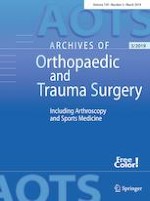Erschienen in:

07.12.2018 | Hip Arthroplasty
Return to activity following revision total hip arthroplasty
verfasst von:
Gareth S. Turnbull, Chloe E. H. Scott, Deborah J. MacDonald, Steffen J. Breusch
Erschienen in:
Archives of Orthopaedic and Trauma Surgery
|
Ausgabe 3/2019
Einloggen, um Zugang zu erhalten
Abstract
Background
Demand for revision total hip arthroplasty (RTHA) continues to grow worldwide and is expected to more than double within the next 1–2 decades. The primary aim of this study was to examine return to function following revision THA in a UK population.
Patients and methods
We assessed 118 patients (132 RTHAs, mean age 65 years SD 13, range 23–88) at a mean follow-up of 7.9 years (SD 4.4) postoperatively. Preoperative age, gender, BMI, social deprivation, operative indication, comorbidities, activity level (UCLA score) and Oxford Hip Scores (OHS) were recorded. Postoperative UCLA score, OHS, EQ-5D, satisfaction levels and performance in activities of daily living (ADLs) were obtained and univariate and multivariate analysis performed.
Results
Mean UCLA activity score improved following RTHA (p < 0.001): UCLA activity score improved in 37% and was unchanged in 50%; 49% of patients engaged in at least moderate level activities (UCLA score ≥ 6). Patient BMI, gender, age and reason for revision did not influence levels of pain, stiffness or activity at follow-up. Preoperative UCLA activity scores (p < 0.001) independently predicted long-term UCLA scores. Independent predictors (p < 0.05) of poor hip-specific function (OHS) following revision included social deprivation, revision for periprosthetic fracture and lower preoperative OHS. Difficulties with ADLs were associated with increasing deprivation, ≥ 3 comorbidities, and revision for periprosthetic fracture or infection (p < 0.05). Overall, 79% of patients remained satisfied or very satisfied following revision THA. Following RTHA, 10% suffered a dislocation and 13% required reoperation for complications.
Conclusion
Revision THA facilitates long-term return to preoperative levels of physical activity in the majority of patients, though activity levels increase in one-third only. Overall over three-quarters are satisfied with their outcome, but revision for periprosthetic fracture or dislocation gives the worse overall outcomes and lower satisfaction levels.